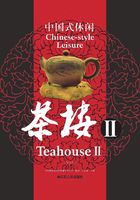
Preface
Teahouse, the Carrier of Chinese Culture
In recent years, oriental cultures, mainly Chinese culture, have set off a craze all over the world. The idea of tea, Chinese architecture (more specifically, Chinese-style design, but I feel it would be too narrow, so I have chosen the general term "Chinese architecture") have attracted more and more worldwide attention. We know from the feedback from the sales channels that the book Chinese-style Leisure: Teahouse we published last year has not only won high praise from people in our nation, but has also been a best-seller in bookstores in major customs and airports and read by many foreign friends.
The opportunity of my publishing the teahouse book came like this: one afternoon, communication with Professor Xi Jin of Chang'an University woke up my deep love for our ancestors' treasure——tea. Then I decided to do something that I was capable of for the traditional Chinese culture. Chinese culture of five thousand years has great impact on the world. Apart from the four great inventions of ancient China, there are another five great things in Chinese culture that have find their places in the world——china, silk, tea, traditional Chinese medicine and Chinese architecture. In that talk, Professor Xi Jin specially introduced to me Chinese architecture. Chinese architecture distinguishes itself from that of any country or any nation. It attaches importance on nature, culture, recycle, energy saving and environmental protection. It should be Chinese people's signs and symbols.
Totally by chance, I found teahouse could be a good carrier, because it is unlike ordinary residential buildings which are simple match, and it is more unlike hotels which are combination of details. Teahouse has not only combined tea, china and Chinese architecture, actually it also contains Chinese culture——Confucian culture. In every teahouse, you can smell special fragrance of tea, see a variety of ceramic products and smell ink fragrance of Chinese culture. In a teahouse, there are small bridge, flowing water and fragrance of bamboo, which are elegant and quiet. All these elements combine Chinese culture of different places with the teahouse in a good way. This time, we have published Chinese-style Leisure: Teahouse Ⅱ, the compositions we selected are more representative than those in last book and oriental culture is expressed more deeply and more purely.
We hope this book could be a carrier of Chinese culture. After a few years, readers can still feel atmosphere of Chinese culture of five thousand years when reading it.
XuBinBin
Shenzhen Chuangyang Cultural Dissemination Co., Ltd.